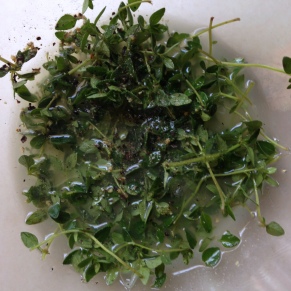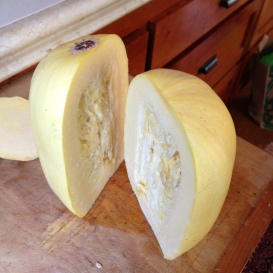We are trying to get ourselves back on track after a VERY naughty holiday season…I’m talking Thanksgiving THROUGH the New Year. NAUGHTY!
So this week I’ve been a cooking machine. On Monday, teriyaki shrimp with grilled pineapple, red peppers and broccoli over cauliflower rice. On Tuesday, zucchini noodles and sauteed chard with turkey meatballs and kale pesto. And then last night. Oh, last night! It was DELICIOUS! I made a variation of this recipe that was sort of pad thai, sort of chicken satay salad. I didn’t have tamarind and wasn’t sure I would have the time to make or buy the ingredients…so that is when I veered away from pad thai…and went more towards the Thai peanut sauce I had in the fridge. I also upped the veggie content. Mama needs some green in her din-din. Also, our new nanny is vegetarian so it is challenging me to not only make more strictly vegetarian meals, but meals that can be eaten both vegetarian and high in meat proteins. Always up for a challenge.
Ingredients (for four people):
- 1 large spaghetti squash
- 2 large carrots
- four scallions or green onions
- 1 bag of bean sprouts
- extra large handful of spinach
- 1 medium yellow onion
- 3 large eggs, whisked
- about 6-8 chicken tenders
- 1 package of extra firm tofu
- Thai Peanut Sauce
- peanut oil
- corn starch
- chopped peanuts
- cilantro
- lime wedges
Preheat the oven to 400 degrees. Prepare all of the ingredients mis en plas prior to cooking as once you start cooking, it will go quickly.
While the oven heats, cut the spaghetti squash lengthwise (stem to stern), scoop out the seeds and innards, cover both sides with olive oil, and sprinkle the insides of the squash with salt and pepper. If you have a dish large enough, you can put them side-by-side, face down in a pan. I don’t, so I put them in two pans. Then add about a 1/4 inch of water to the pan. Depending on your oven, it could take about 30-40 minutes. You’ll know when they are done when you poke at the top and the side collapses a bit. Be wary of the steam when opening the oven. The water makes that first burst of steam VERY hot. [Side note: I used a convection oven so it cut down the time to about 20 minutes.] [Side note(2): You can do this the night before to save time…spaghetti squash does well in the refrigerator for a few days.]
During the time the spaghetti squash is cooking, prep everything else. Cut your tofu into cubes and sprinkle with about two tablespoons of corn starch. Mix these together and let sit. Skewer the chicken and sprinkle both sides with salt and pepper. Make ribbons of the carrots using a veggie peeler. Roughly chop the spinach. Thinly slice your yellow onion (I used a sprializer to make the process fast and easy). Whisk your eggs. Prepare your green onions by cutting off the white ends and chopping them on the bias…about quarter to half inch pieces. Have everything ready in bowls next to your stove.
This is also a good time to sear the chicken skewers. If you have a grill pan, use it. If not, a shallow pan works best (maybe something you use for pancakes). Spray the pan with oil and sear both sides of the skewers until both sides are golden brown where it touches the pan and the interior is beginning to turn white. You will put them in the oven to cook through when the spaghetti squash is out.
Put a wok or large pan on the stove on high heat. Set two large bowls to the side of the stove for the cooked food. We’ll do this in steps. When the wok is hot, add a few teaspoons of peanut oil and coat the pan. Add the tofu and cook until all sides are golden brown. Put into the bowl when finished. Keeping the pan hot, add a bit more peanut oil and cook the onions until slightly browned and softened. Add these to the bowl with the tofu when cooked. Add a bit more oil, then pour in the eggs, rolling it around the pan making a thin omelette. My experience had me letting the center “set” a bit instead of continually moving it around the pan. Once it begins to set, cut it with your tongs into small pieces and it will finish cooking quickly. Add this to the bowl on top of the tofu and onions. Turn off the heat for the pan and check the spaghetti squash.
At this point it should be softening. If so, remove the pans from the oven and let them cool while you begin cooking the other veggies. Don’t cook the veggies until the spaghetti squash is ready because you’ll want the veggies warm and don’t want to overcook them. When the spaghetti squash has slightly cooled, drain the water from the pan(s) and turn them over using either a fork or a oven mitt. Using a fork, shred the inside into “noodles.”
Put the seared chicken skewers in the (now dry) pan the spaghetti squash was in and into the hot oven (still at 400 degrees) with the skewer part covered in tinfoil. These will be ready by the time everything else cooks. Use a meat thermometer to double check, though.
Turn the heat back up on the wok and add a splash of peanut oil. Add the carrots, bean sprouts, and green onions to the pan. After a minute or two, turning the veggies often, add the spinach, mixing the spinach in with the rest of the veggies. Add those veggies to the second bowl and set aside. In the hot wok add just a splash more peanut oil, coat the pant, and put the spaghetti squash noodles into the pan in a even layer around the pan. Let them sit for a bit to get some crunch. Stir again and let sit.
While that sits, add three or four tablespoons of the peanut sauce to a bowl and add a splash of hot water to thin out the sauce. Pour some of this sauce around the edge of the pan and mix it into the spaghetti squash. Once well mixed, add all of the other ingredients and stir in the remaining sauce. Check the chicken. Remove when finished
Plate the dish and finish with chopped peanuts, chopped cilantro, and two lime wedges. Drizzle the peanut sauce (not thinned) over the whole plate. Ta da! Enjoy!












